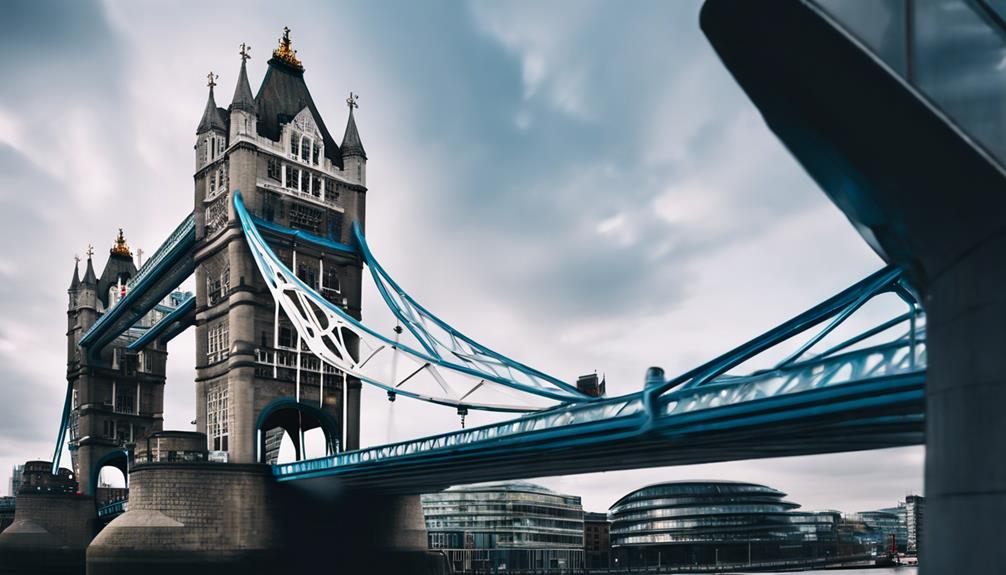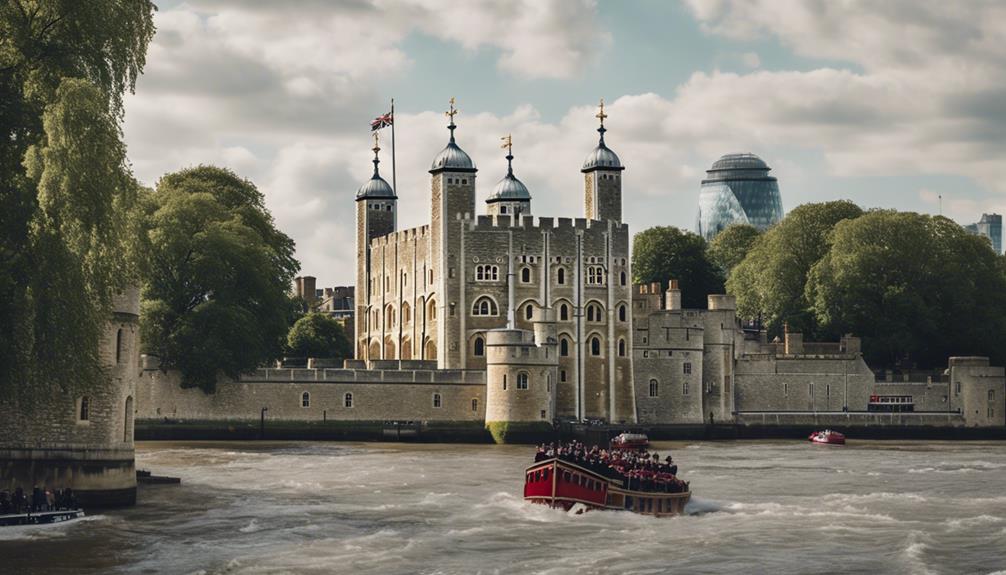London's must-see sights include the iconic Tower of London, where history breathes within its ancient walls. Next, head to Westminster Abbey for a glimpse of royal events and the famous Coronation Chair. Embrace the vibrant culture at the British Museum, housing diverse artifacts and offering insightful guided tours. Experience regal charm at Buckingham Palace and feast your eyes on the architectural wonder of St. Paul's Cathedral. For a modern twist, don't miss The Shard standing tall at 310 meters or the glass skyscraper The Gherkin. Explore London Eye for breathtaking panoramic views and immerse yourself in the lively hub of Piccadilly Circus.
Key Takeaways
- Tower of London: Medieval fortress and notorious prison.
- The Shard: Iconic modern skyscraper with breathtaking views.
- British Museum: Diverse artifacts and historical treasures.
- Buckingham Palace: Regal charm and royal history.
- Tate Modern: Contemporary art by renowned artists.
Historical Landmarks in London
Explore London's rich historical heritage by visiting some of the city's most iconic landmarks. Start your journey at the Tower of London, a fortress commissioned by William the Conqueror with a fascinating historical background.
Continue to Westminster Abbey, where royal events and burials take place, housing the Coronation Chair and Poets' Corner. Immerse yourself in culture at the British Museum, showcasing artifacts from diverse cultures and offering guided tours and audio guides.
For a royal experience, visit Buckingham Palace and Hampton Court Palace, each with its own regal charm and historical significance. Admire the architectural marvel of St. Paul's Cathedral and the art collections at the National Gallery.
Learn about wartime history at the Imperial War Museum and marvel at the engineering feat of Tower Bridge. Complete your historical tour with a visit to Tate Modern, a hub of contemporary art housed in a former power station.
London's historical landmarks offer a fascinating journey through time and culture.
Iconic Modern Architecture

London's skyline boasts a stunning array of iconic modern architecture, showcasing innovative designs and engineering marvels. The Shard, standing tall at 310 meters with 95 floors, dominates the cityscape as the tallest building in the United Kingdom.
Designed by renowned architect Norman Foster, the Gherkin, officially known as 30 St Mary Axe, is a striking glass skyscraper in London's bustling financial district.
Offering breathtaking panoramic views of the city, the London Eye, a massive Ferris wheel on the South Bank of the River Thames, stands at 135 meters high.
The Sky Garden at 20 Fenchurch Street is a unique public space featuring lush gardens, observation decks, and an open-air terrace, providing visitors with a serene escape above the bustling streets.
In the vibrant West End, Piccadilly Circus is a lively hub known for its dazzling illuminated advertising displays and diverse range of tourist attractions. These architectural wonders add a modern charm to London's rich historical tapestry.
Cultural Delights Across London

Immerse yourself in the vibrant cultural scene of London, where a plethora of museums, galleries, and iconic landmarks await your exploration. Take a journey through time and art by exploring these must-see cultural delights across London:
- British Museum: Explore ancient civilizations with Egyptian mummies and Greek sculptures.
- National Gallery: Admire English paintings spanning from the 13th to 19th centuries, including masterpieces by Van Gogh and da Vinci.
- Tate Modern: Discover modern and contemporary art featuring works by Picasso, Warhol, and Hockney.
- Madame Tussauds: Meet lifelike wax figures of celebrities, historical figures, and royalty.
- London Landmarks: Discover the historical wonders of the Tower of London, Westminster Abbey, Big Ben, Tower Bridge, and the scenic Thames River.
These cultural gems offer a diverse and enriching experience, showcasing the rich history and artistic legacy of London for you to enjoy.
Hidden Gems for Explorers

Uncover hidden gems in London for the curious explorer looking beyond the well-trodden paths. While London boasts famous landmarks like the Tower of London and Buckingham Palace, there are lesser-known treasures waiting to be discovered by adventurous visitors. Dive into the city's rich history by exploring the Horniman Museum, home to diverse collections spanning natural history, cultural artifacts, and musical instruments. For art enthusiasts, a visit to the Wallace Collection offers a chance to marvel at intricate armor, exquisite paintings, and elegant furniture. To experience a taste of royalty, consider witnessing the Changing of the Guard ceremony outside Buckingham Palace. If you prefer a more relaxed atmosphere, take a stroll through charming neighborhoods such as Notting Hill and Kensington. For a day trip, venture to Hampton Court Palace or the historic cities of Bath and Oxford. These hidden gems provide a deeper insight into London's cultural tapestry beyond the well-known attractions.
| Hidden Gems | Description |
|---|---|
| Horniman Museum | Eclectic collections of natural history and cultural artifacts |
| Wallace Collection | Extensive array of fine arts, armor, and furniture |
| Changing of the Guard | Royal ceremony at Buckingham Palace |
| Notting Hill & Kensington | Peaceful neighborhoods for leisurely walks |
| Day Trips | Explore historic sites like Hampton Court Palace, Bath, and Oxford |
Must-Visit Historical Sites

Discover London's must-visit historical sites, each brimming with centuries of rich stories and royal legacies.
- Tower of London: Founded in 1066 after the Norman Conquest, this historic castle served as a royal residence and a notorious prison.
- Westminster Abbey: Constructed by King Edward the Confessor, this iconic medieval church hosts royal events and burials.
- Buckingham Palace: Since 1837, this Royal Residence has been the official home of British monarchs, renovated by past rulers like George III and Queen Victoria.
- Hampton Court Palace: A favorite of Henry VIII, this Historic Royal Palace was leased by Thomas Wolsey and enjoyed by monarchs such as Elizabeth I.
- Kensington Palace: Acquired by King William III, this Royal Residence was enhanced by Christopher Wren and was once home to minor Royals during George III's reign.
These sites offer a glimpse into the rich history and grandeur of London's past, allowing you to immerse yourself in the stories of kings, queens, and historic events that have shaped the city's heritage.
Frequently Asked Questions
What Don't Miss in London?
When in London, don't miss iconic sights like the Tower of London, Houses of Parliament, Big Ben, Buckingham Palace, and Greenwich. These locations offer rich historical insights and cultural experiences that define the city's essence.
Explore the diverse architecture, royal heritage, and maritime history showcased in these must-see spots. Immerse yourself in London's vibrant past and present by visiting these renowned landmarks.
What Is the Most Historic Thing in London?
You can't explore the Tower of London, a truly historic gem that stands tall as a symbol of London's past. This monumental castle, dating back to 1066, encapsulates centuries of history within its walls.
From royal ceremonies to imprisonments, the Tower's storied past makes it a must-see for history buffs and visitors alike. Immerse yourself in the rich tapestry of London's history as you explore this iconic landmark.
What Is the Most Famous London's Sight?
The most famous sight in London is the Tower of London. This historic castle, established in 1066, has a rich past as a prison, royal residence, and treasury.
It houses the Crown Jewels of England and is surrounded by defensive walls and a moat. Despite its ominous reputation, only seven executions occurred there before the 20th century.
Today, it remains a top tourist spot, managed by the Resident Governor and protected by the Yeomen Warders.
What Is the Best Way to See All the Sites in London?
To see all the sites in London efficiently, consider purchasing a London Pass for access to over 80 attractions. Opt for guided tours or hop-on-hop-off bus tours and use public transportation like the Tube.
Plan strategically to cover a mix of famous landmarks and modern attractions. Take advantage of combo tickets to visit multiple destinations in one go. This way, you can make the most of your time exploring London's diverse sights.
Conclusion
After exploring London's historical landmarks, iconic modern architecture, cultural delights, and hidden gems, you'll surely be left in awe of this vibrant city's rich tapestry of past and present.
Just like Sarah, a first-time visitor who was captivated by the stunning views from The Shard and the intricate details of the Tower of London.
With so much to see and experience, London truly offers something for everyone.
Start planning your trip today and immerse yourself in the beauty and history of this incredible city.









